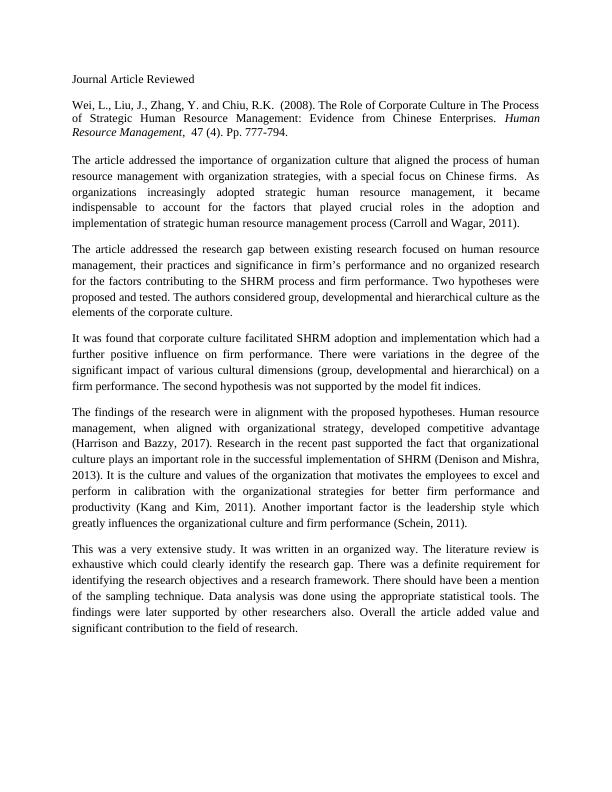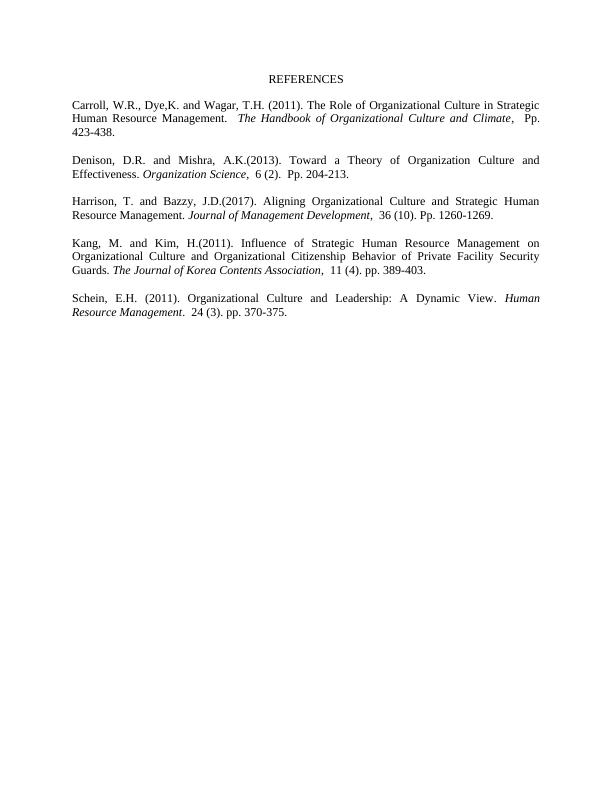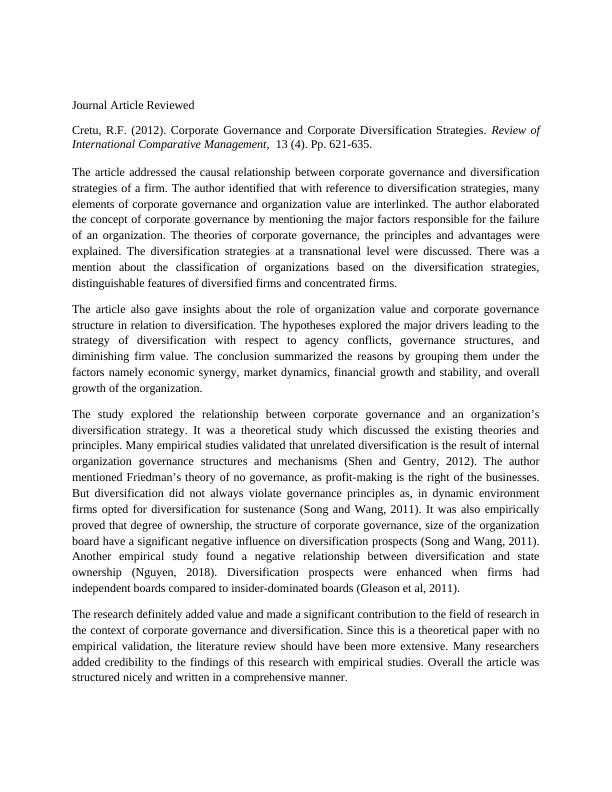The Role of Corporate Culture in Strategic Human Resource Management
Added on 2023-01-19
6 Pages1824 Words63 Views
Journal Article Reviewed
Wei, L., Liu, J., Zhang, Y. and Chiu, R.K. (2008). The Role of Corporate Culture in The Process
of Strategic Human Resource Management: Evidence from Chinese Enterprises. Human
Resource Management, 47 (4). Pp. 777-794.
The article addressed the importance of organization culture that aligned the process of human
resource management with organization strategies, with a special focus on Chinese firms. As
organizations increasingly adopted strategic human resource management, it became
indispensable to account for the factors that played crucial roles in the adoption and
implementation of strategic human resource management process (Carroll and Wagar, 2011).
The article addressed the research gap between existing research focused on human resource
management, their practices and significance in firm’s performance and no organized research
for the factors contributing to the SHRM process and firm performance. Two hypotheses were
proposed and tested. The authors considered group, developmental and hierarchical culture as the
elements of the corporate culture.
It was found that corporate culture facilitated SHRM adoption and implementation which had a
further positive influence on firm performance. There were variations in the degree of the
significant impact of various cultural dimensions (group, developmental and hierarchical) on a
firm performance. The second hypothesis was not supported by the model fit indices.
The findings of the research were in alignment with the proposed hypotheses. Human resource
management, when aligned with organizational strategy, developed competitive advantage
(Harrison and Bazzy, 2017). Research in the recent past supported the fact that organizational
culture plays an important role in the successful implementation of SHRM (Denison and Mishra,
2013). It is the culture and values of the organization that motivates the employees to excel and
perform in calibration with the organizational strategies for better firm performance and
productivity (Kang and Kim, 2011). Another important factor is the leadership style which
greatly influences the organizational culture and firm performance (Schein, 2011).
This was a very extensive study. It was written in an organized way. The literature review is
exhaustive which could clearly identify the research gap. There was a definite requirement for
identifying the research objectives and a research framework. There should have been a mention
of the sampling technique. Data analysis was done using the appropriate statistical tools. The
findings were later supported by other researchers also. Overall the article added value and
significant contribution to the field of research.
Wei, L., Liu, J., Zhang, Y. and Chiu, R.K. (2008). The Role of Corporate Culture in The Process
of Strategic Human Resource Management: Evidence from Chinese Enterprises. Human
Resource Management, 47 (4). Pp. 777-794.
The article addressed the importance of organization culture that aligned the process of human
resource management with organization strategies, with a special focus on Chinese firms. As
organizations increasingly adopted strategic human resource management, it became
indispensable to account for the factors that played crucial roles in the adoption and
implementation of strategic human resource management process (Carroll and Wagar, 2011).
The article addressed the research gap between existing research focused on human resource
management, their practices and significance in firm’s performance and no organized research
for the factors contributing to the SHRM process and firm performance. Two hypotheses were
proposed and tested. The authors considered group, developmental and hierarchical culture as the
elements of the corporate culture.
It was found that corporate culture facilitated SHRM adoption and implementation which had a
further positive influence on firm performance. There were variations in the degree of the
significant impact of various cultural dimensions (group, developmental and hierarchical) on a
firm performance. The second hypothesis was not supported by the model fit indices.
The findings of the research were in alignment with the proposed hypotheses. Human resource
management, when aligned with organizational strategy, developed competitive advantage
(Harrison and Bazzy, 2017). Research in the recent past supported the fact that organizational
culture plays an important role in the successful implementation of SHRM (Denison and Mishra,
2013). It is the culture and values of the organization that motivates the employees to excel and
perform in calibration with the organizational strategies for better firm performance and
productivity (Kang and Kim, 2011). Another important factor is the leadership style which
greatly influences the organizational culture and firm performance (Schein, 2011).
This was a very extensive study. It was written in an organized way. The literature review is
exhaustive which could clearly identify the research gap. There was a definite requirement for
identifying the research objectives and a research framework. There should have been a mention
of the sampling technique. Data analysis was done using the appropriate statistical tools. The
findings were later supported by other researchers also. Overall the article added value and
significant contribution to the field of research.

REFERENCES
Carroll, W.R., Dye,K. and Wagar, T.H. (2011). The Role of Organizational Culture in Strategic
Human Resource Management. The Handbook of Organizational Culture and Climate, Pp.
423-438.
Denison, D.R. and Mishra, A.K.(2013). Toward a Theory of Organization Culture and
Effectiveness. Organization Science, 6 (2). Pp. 204-213.
Harrison, T. and Bazzy, J.D.(2017). Aligning Organizational Culture and Strategic Human
Resource Management. Journal of Management Development, 36 (10). Pp. 1260-1269.
Kang, M. and Kim, H.(2011). Influence of Strategic Human Resource Management on
Organizational Culture and Organizational Citizenship Behavior of Private Facility Security
Guards. The Journal of Korea Contents Association, 11 (4). pp. 389-403.
Schein, E.H. (2011). Organizational Culture and Leadership: A Dynamic View. Human
Resource Management. 24 (3). pp. 370-375.
Carroll, W.R., Dye,K. and Wagar, T.H. (2011). The Role of Organizational Culture in Strategic
Human Resource Management. The Handbook of Organizational Culture and Climate, Pp.
423-438.
Denison, D.R. and Mishra, A.K.(2013). Toward a Theory of Organization Culture and
Effectiveness. Organization Science, 6 (2). Pp. 204-213.
Harrison, T. and Bazzy, J.D.(2017). Aligning Organizational Culture and Strategic Human
Resource Management. Journal of Management Development, 36 (10). Pp. 1260-1269.
Kang, M. and Kim, H.(2011). Influence of Strategic Human Resource Management on
Organizational Culture and Organizational Citizenship Behavior of Private Facility Security
Guards. The Journal of Korea Contents Association, 11 (4). pp. 389-403.
Schein, E.H. (2011). Organizational Culture and Leadership: A Dynamic View. Human
Resource Management. 24 (3). pp. 370-375.

Journal Article Reviewed
Cretu, R.F. (2012). Corporate Governance and Corporate Diversification Strategies. Review of
International Comparative Management, 13 (4). Pp. 621-635.
The article addressed the causal relationship between corporate governance and diversification
strategies of a firm. The author identified that with reference to diversification strategies, many
elements of corporate governance and organization value are interlinked. The author elaborated
the concept of corporate governance by mentioning the major factors responsible for the failure
of an organization. The theories of corporate governance, the principles and advantages were
explained. The diversification strategies at a transnational level were discussed. There was a
mention about the classification of organizations based on the diversification strategies,
distinguishable features of diversified firms and concentrated firms.
The article also gave insights about the role of organization value and corporate governance
structure in relation to diversification. The hypotheses explored the major drivers leading to the
strategy of diversification with respect to agency conflicts, governance structures, and
diminishing firm value. The conclusion summarized the reasons by grouping them under the
factors namely economic synergy, market dynamics, financial growth and stability, and overall
growth of the organization.
The study explored the relationship between corporate governance and an organization’s
diversification strategy. It was a theoretical study which discussed the existing theories and
principles. Many empirical studies validated that unrelated diversification is the result of internal
organization governance structures and mechanisms (Shen and Gentry, 2012). The author
mentioned Friedman’s theory of no governance, as profit-making is the right of the businesses.
But diversification did not always violate governance principles as, in dynamic environment
firms opted for diversification for sustenance (Song and Wang, 2011). It was also empirically
proved that degree of ownership, the structure of corporate governance, size of the organization
board have a significant negative influence on diversification prospects (Song and Wang, 2011).
Another empirical study found a negative relationship between diversification and state
ownership (Nguyen, 2018). Diversification prospects were enhanced when firms had
independent boards compared to insider-dominated boards (Gleason et al, 2011).
The research definitely added value and made a significant contribution to the field of research in
the context of corporate governance and diversification. Since this is a theoretical paper with no
empirical validation, the literature review should have been more extensive. Many researchers
added credibility to the findings of this research with empirical studies. Overall the article was
structured nicely and written in a comprehensive manner.
Cretu, R.F. (2012). Corporate Governance and Corporate Diversification Strategies. Review of
International Comparative Management, 13 (4). Pp. 621-635.
The article addressed the causal relationship between corporate governance and diversification
strategies of a firm. The author identified that with reference to diversification strategies, many
elements of corporate governance and organization value are interlinked. The author elaborated
the concept of corporate governance by mentioning the major factors responsible for the failure
of an organization. The theories of corporate governance, the principles and advantages were
explained. The diversification strategies at a transnational level were discussed. There was a
mention about the classification of organizations based on the diversification strategies,
distinguishable features of diversified firms and concentrated firms.
The article also gave insights about the role of organization value and corporate governance
structure in relation to diversification. The hypotheses explored the major drivers leading to the
strategy of diversification with respect to agency conflicts, governance structures, and
diminishing firm value. The conclusion summarized the reasons by grouping them under the
factors namely economic synergy, market dynamics, financial growth and stability, and overall
growth of the organization.
The study explored the relationship between corporate governance and an organization’s
diversification strategy. It was a theoretical study which discussed the existing theories and
principles. Many empirical studies validated that unrelated diversification is the result of internal
organization governance structures and mechanisms (Shen and Gentry, 2012). The author
mentioned Friedman’s theory of no governance, as profit-making is the right of the businesses.
But diversification did not always violate governance principles as, in dynamic environment
firms opted for diversification for sustenance (Song and Wang, 2011). It was also empirically
proved that degree of ownership, the structure of corporate governance, size of the organization
board have a significant negative influence on diversification prospects (Song and Wang, 2011).
Another empirical study found a negative relationship between diversification and state
ownership (Nguyen, 2018). Diversification prospects were enhanced when firms had
independent boards compared to insider-dominated boards (Gleason et al, 2011).
The research definitely added value and made a significant contribution to the field of research in
the context of corporate governance and diversification. Since this is a theoretical paper with no
empirical validation, the literature review should have been more extensive. Many researchers
added credibility to the findings of this research with empirical studies. Overall the article was
structured nicely and written in a comprehensive manner.

End of preview
Want to access all the pages? Upload your documents or become a member.
Related Documents
021407 - Strategic Human Resource Managementlg...
|6
|1622
|21
research projectlg...
|11
|446
|28
Organizational Culture: A Study of its Impact on Innovation, Job Satisfaction, and Organizational Effectivenesslg...
|14
|1750
|95
Contemporary Issues in SHRMlg...
|10
|1798
|157
Critical Review of Articleslg...
|10
|2195
|27
Organizational Behavior: Types of Organizational Structure, Organizational Culture Theory, Innovation and Creativity, Learning Importance, Team Effectiveness, Change Managementlg...
|11
|557
|51
